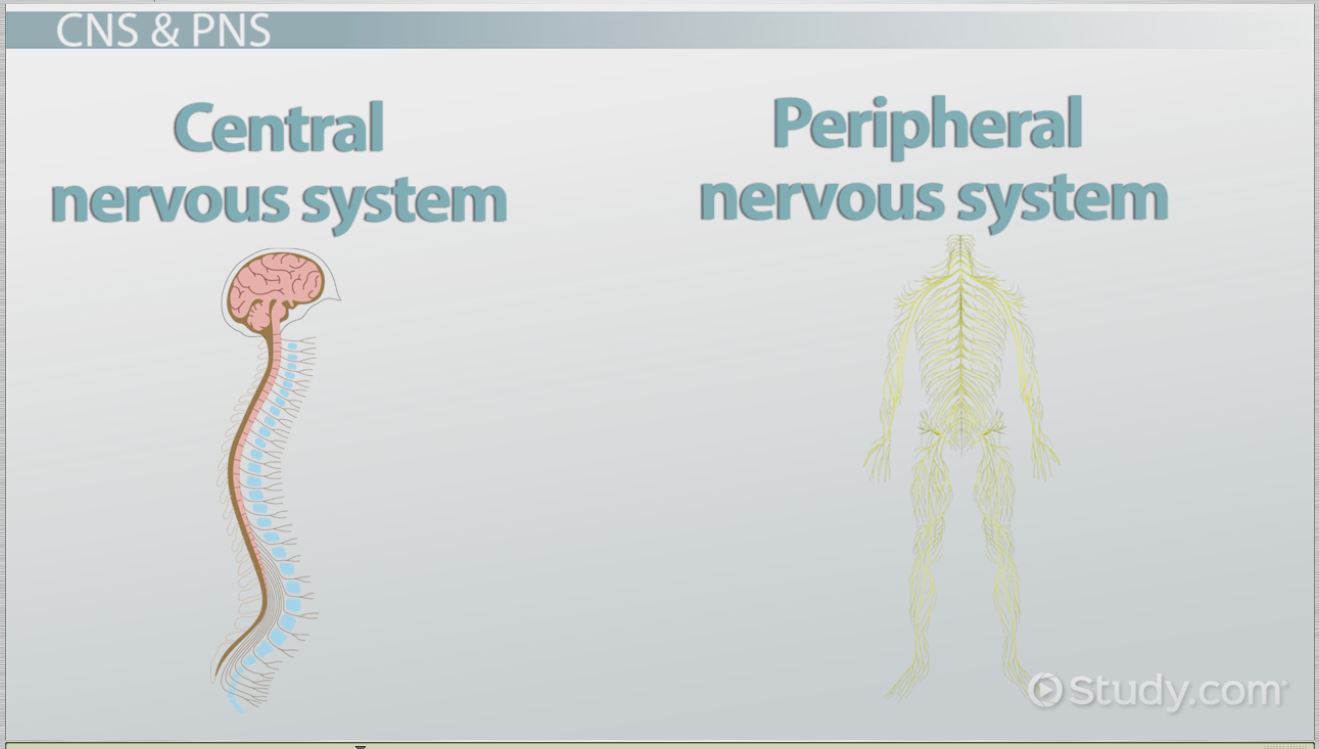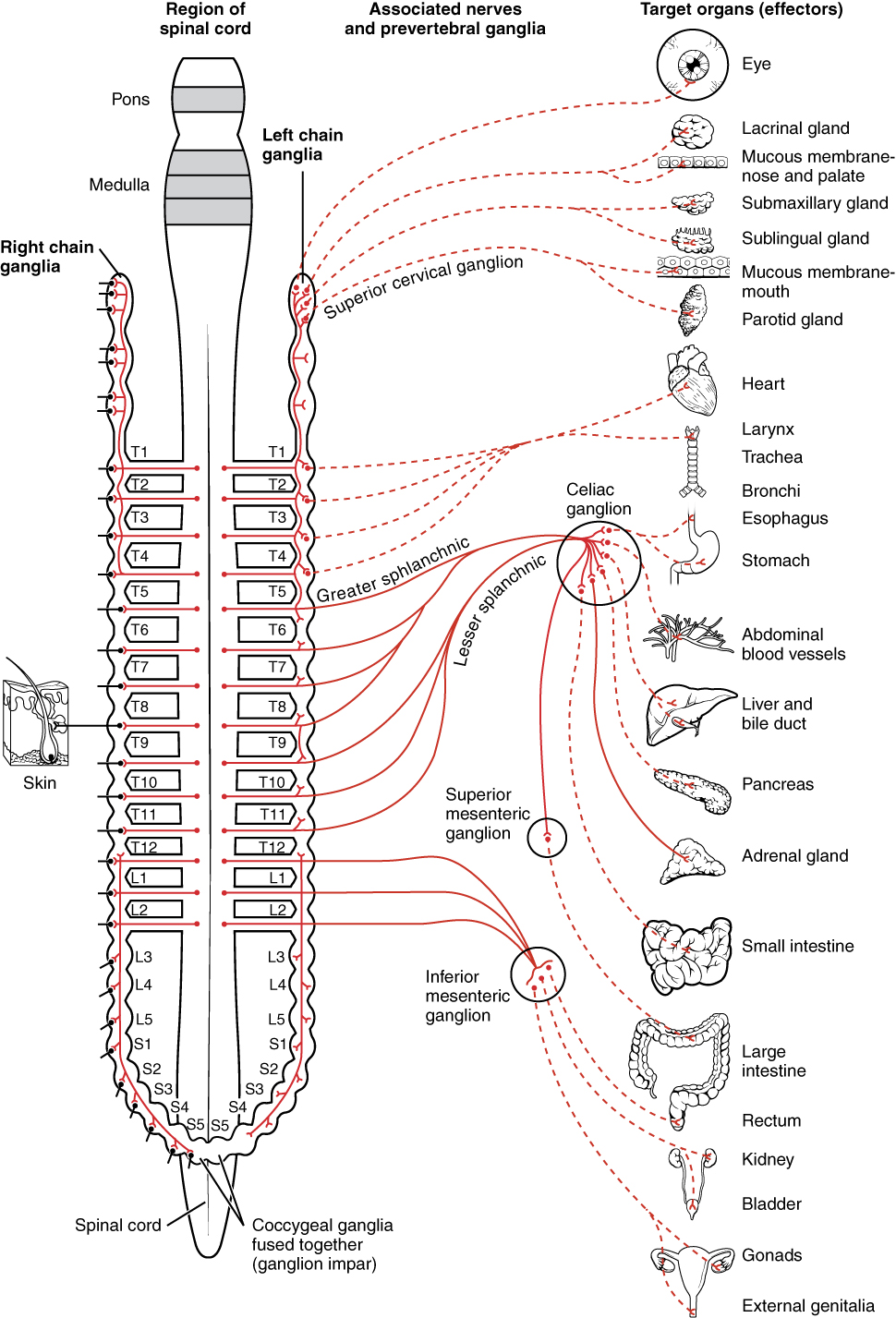The nervous system is a complex collection of nerves and specialized cells known as neurons that transmit signals between different parts of the body. It is essentially the body's electrical. The nervous system is made up of all the nerve cells in your body. It is through the nervous system that we communicate with the outside world and, at the same. The nervous system is made up of millions and millions of neurons (say: NURonz), which are microscopic cells. Each neuron has tiny branches coming off it that let it connect to many other neurons. When you were born, your brain came with all the neurons it will ever have, but many of them were not connected to each other. The nervous system monitors and controls almost every organ system through a series of positive and negative feedback loops. The Central Nervous System (CNS) includes the brain and spinal cord. The Peripheral Nervous System (PNS) connects the CNS to other parts of the body, and is composed of nerves (bundles of neurons). Alzheimer's disease (AD) is the most common cause of dementia in industrialized nations. Dementia is a brain disorder that interferes with a person's ability to carry out everyday activities. The autonomic nervous system is divided into three parts: the sympathetic nervous system, the parasympathetic nervous system and the enteric nervous system. The autonomic nervous system controls smooth muscle of the viscera (internal organs) and glands. The system of neurons and tissues that regulates the actions and responses of vertebrates and many invertebrates. The nervous system of vertebrates is a complex system that consists mainly of the brain, spinal cord, and peripheral and autonomic nerves. Nervous system definition is the bodily system that in vertebrates is made up of the brain and spinal cord, nerves, ganglia, and parts of the receptor organs and that receives and interprets stimuli and transmits impulses to the effector organs. The central nervous system is composed of the brain and spinal cord. Your brain and spinal cord serve as the main processing center for your entire nervous system. The central nervous system (CNS) is the processing center for the nervous system. It receives information from and sends information to the peripheral nervous system. The two main organs of the CNS are the brain and spinal cord. Human nervous system, system that conducts stimuli from sensory receptors to the brain and spinal cord and that conducts impulses back to other parts of the body. As with other higher vertebrates, the human nervous system has two main parts: the central nervous system. Hank begins a series of videos on organ systems with a look at the nervous system and all of the things that it is responsible for in the body. The nervous system is also involved in the senses of sight, hearing, taste, touch and smell. Special nerve cells carry information from your eyes, ears, nose, tongue and skin to your brain. Autonomic nervous system disorders can occur alone or as the result of another disease, such as Parkinson's disease, alcoholism and diabetes. Problems can affect either part of the system, as in complex regional pain syndromes, or all of the system. The central nervous system consists of the brain and spinal cord (see Multimedia File 1). The brain plays a central role in the control of most bodily functions, including awareness, movements, sensations, thoughts, speech, and memory. The human nervous system is composed of two parts: the central nervous system, which includes the brain and spinal cord, and the peripheral nervous system, which is composed of nerves and nerve networks throughout the body. The central nervous system (CNS) is the part of the nervous system consisting of the brain and spinal cord. The central nervous system is so named because it integrates information it receives from, and coordinates and influences the activity of. Central nervous system definition is the part of the nervous system which in vertebrates consists of the brain and spinal cord, to which sensory impulses are transmitted and from which motor impulses pass out, and which coordinates the activity of the entire nervous system. The autonomic nervous system has two parts: the sympathetic and the parasympathetic nervous systems. The sympathetic nervous system prepares the body for sudden stress, like if you see a robbery taking place. The nervous system is a master system that controls the functions of all different systems of a human body. The nervous system, essentially the bodys electrical wiring, is a complex collection of nerves and specialized cells known as neurons that transmit signals between different parts of the body. The nervous system consists of the brain, spinal cord, sensory organs, and all of the nerves that connect these organs with the rest of the body. Together, these organs are responsible for the control of the body and communication among its parts. The central nervous system includes the brain and spinal cord. The brain and spinal cord are protected by bony structures, membranes, and fluid. The brain is held in the cranial cavity of the skull and it consists of the cerebrum, cerebellum, and the brain stem. nervous system is composed of excitable nerve cells (neurons) and synapses that form between the neurons and connect them to centers throughout the body or to other neurons. Brain and nervous system problems are common. These neurological disorders include multiple sclerosis, Alzheimers disease, Parkinsons disease, epilepsy, and. The central nervous system is made up of the brain and spinal cord. The peripheral nervous system is made up of the nerve fibers that branch off from the spinal cord and extend to all parts of the body, including the neck and arms, torso, legs, skeletal muscles and internal organs. That network your nervous system has two parts: Your brain and spinal cord make up your central nervous system. The nerves in the rest of your body make up your peripheral nervous system. This system can be divided into two parts: the central nervous system (CNS) and the peripheral nervous system (PNS). The CNS is composed of the brain and spinal cord, which function to receive, process, and send information to the PNS. The nervous system includes the central and peripheral nervous systems. The sense organs, including the eye, contain receptors that are sensitive to stimuli and respond with reflex actions. Welcome to the brave new world of bioelectronics: implants that can communicate directly with the nervous system in order to try to fight everything from cancer to the common cold. The somatic nervous system is subdivided into sensory and motor components. The somatic senses, mechanoreception, thermoreception, and pain, are the mechanisms for gathering sensory information from the body, and are distinct from the special senses. The nervous system is a complex network of nerves and cells that carry messages to and from the brain and spinal cord to various parts of the body. The nervous system includes both the Central. The nervous system is the highway along which your brain sends and receives information about what is happening in the body and around it. This highway is made up of billions of nerve cells, or neurons (say newrons) which join together to make nerves. Nervous System is a design studio that works at the intersection of science, art, and technology. We create using a novel process that employs computer simulation to generate designs and digital fabrication to realize products. The nervous system is no doubt one of the most complex systems of the human body, but that doesn't make it any less interesting. It is a network of cells by which messages are relayed back and forth between the brain and various The two major parts to the Nervous System are the Central Nervous System and the Peripheral Nervous System. The Central Nervous System is also. The system of cells, tissues, and organs that regulates the body's responses to internal and external stimuli. In vertebrates it consists of the brain, spinal cord, nerves, ganglia, and parts of the receptor and effector organs. the system of neurons, neurochemicals, and allied structures involved. The latest Tweets from Nervous System (@nervoussystem). a generative design studio that works at the intersection of science, art, and technology. follow @nervousjessica @nervousjesse for more frequent updates. Somerville, MA, USA The nervous system has two major parts: the central nervous system (CNS) and the peripheral nervous system (PNS). The central system is the primary command center for the body, and is comprised of. The autonomic nervous system regulates a variety of body process that take place without conscious effort. The autonomic system is the part of the peripheral nervous system that is responsible, as the name implies, for regulating involuntary body functions. Nervous System is a generative design studio that works at the intersection of science, art, and technology. Drawing inspiration from natural phenomena, we create computer simulations to generate designs and use digital fabrication to realize products. Nervous System, Somerville, Massachusetts. Nervous System is a generative design studio that works at the intersection of science, art, and The nervous system is made up of all the nerve cells in your body. It is through the nervous system that we communicate with the outside world and, at the same time, many mechanisms inside our body are controlled. The nervous system uses electrical and chemical means to help all parts of the body to communicate with each other. The brain and spinal cord make up the central nervous system. Nerves everywhere else in the body are part of the peripheral nervous system. The nervous system helps all the parts of. The Nervous Systembr The Nervous System is the master controlling and communicating system of the body. br The Nervous System CONTROLS and COORDINATES ALL ESSENTIAL FUNCTIONS of the Human Body. nervous system the organ system that, along with the endocrine system, correlates the adjustments and reactions of an organism to internal and environmental conditions. It is composed of the brain, spinal cord, and nerves, which act together to serve as the communicating and coordinating system of the body, carrying information to the brain and relaying instructions from the brain. Meaning suffering disorder of the nervous system is from 1734; illogical sense restless, agitated, lacking nerve is 1740. Widespread popular use as a euphemism for mental forced the medical community to coin neurological to replace it in the older sense. That system was the nervous system, which is based upon the almost instantaneous transmission of electrical impulses from one region of the body to another along specialized nerve cells called neurons..











